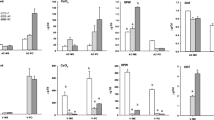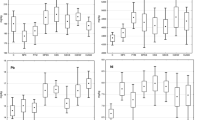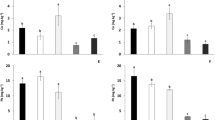Abstract
The addition of organic matter in soil can modify the bioavailability of heavy metals. A greenhouse pot experiment was carried out using an edible plant species Eruca vesicaria L. Cavalieri grown on an artificially contaminated soil with Zn (665 mg kg−1). In this study, the effect of compost at 20 t ha−1 (C20) and at 60 t ha−1 (C60), manure at 10 t ha−1 (M10) and at 30 t ha−1 (M30), and chemical fertilizers (NPK) on Zn fate in a soil–plant system was evaluated. At the end of the experiment, the main growth parameters and Zn content in plants were determined. In addition, Zn speciation in the soil was assessed using the original Community Bureau of Reference sequential extraction and diethylene triamine pentaacetic acid extraction. Zinc, though an essential element for plant growth, caused toxicity effects in plants grown on control and manure treatments, while in the compost treatments, plants showed no visual toxicity symptoms. The concentrations of Zn in roots were similar for all treatments, while significant differences were observed for shoots. In fact, in the compost treatments, plants showed the lowest Zn concentration in shoots. Zinc speciation seems not to be affected by the applied treatments. Indeed, Zn plant content and translocation to shoots seems to be affected. Compost amendments significantly reduced Zn content and translocation in comparison to other treatments.




Similar content being viewed by others

References
Adriano DC (1986) Trace elements in the terrestrial environments. Springer, New York
Adriano DC (2001) Trace elements in terrestrial environments: biogeochemistry, bioavailability and risks of metals, 2nd edn. Springer, New York
Almås A, Singh BR, Salbu B (1999) Mobility of cadmium-109 and zinc-65 in soil influenced by equilibration time, temperature and organic matter. J Environ Qual 28:1742–1750
Baker AJM (2008) Accumulators and excluders—strategies in the response of plants to heavy metals. J Plant Nutr 3:1–4
Baker AJM, Mc Grath SP, Reeves RD, Smith JAC (2000) Metal hyperaccumulator plants: a review of the ecology and physiology of a biological resource for phytoremediation of metal-polluted soils. In: Terry N, Bañuelos G (eds) Phytoremediation of contaminated soil and water. Lewis, Boca Raton, pp 85–107
Barker AV, Bryson GM (2002) Bioremediation of heavy metals and organic toxicants by composting. Sci World J 2:407–420
Basta NT, Ryan JA, Chaney RL (2005) Trace element chemistry in residual-treated soil: key concepts and metal bioavailability. J Environ Qual 34:49–63
Bernal MP, Walker DJ, Clemente R, Roig A (2002) The effect of organic amendments and lime on the bioavailability of heavy metals in contaminated soils. Proceeding of the 17th World Congress of Soil Science, Bangkok, Thailand
Bernal MP, Clemente R, Walker DJ (2009) Interactions of heavy metals with soil organic matter in relation to phytoremediation. In: Navarro-Aviño JP (ed) Phytoremediation: the green salvation of the world. Research Signpost, Kerala, pp 109–129
Bloomfield C (1981) The translocation of metals in soils. In: Greenland DJ, Hayes MHB (eds) The chemistry of soil processes. Wiley, Chichester, pp 463–504
Chen BD, Li XL, Tao HQ, Christies P, Wong MH (2003) The role of arbuscular mycorrhiza in zinc uptake by red clover growing in a calcareous soil spiked with various quantities of zinc. Chemosphere 50:839–846
Clemente R, Bernal MP (2006) Fractionation of heavy metals and distribution of organic carbon in two contaminated soils amended with humic acids. Chemosphere 64:1264–1273
Commission Decision 2006/799/EC of 3 November 2006 establishing revised ecological criteria and the related assessment and verification requirements for the award of the community eco-label to soil improvers. Official Journal L 325:28–34
Council Directive 86/278/EEC of 12 June 1986 on the protection of the environment, and in particular of the soil, when sewage sludge is used in agriculture. Official Journal L 181:6–12
Dassenakis M, Andrianos H, Depiazi G, Konstantas A, Karabela M, Sakellari A, Scoullos M (2003) The use of various methods for the study of metal pollution in marine sediments, the case of Euvoikos Gulf, Greece. Appl Geochem 18:781–794
Davidson CM, Dunca AL, Littlejohn D, Ure AM, Garden LM (1998) Analytical chemistry. Acta 363(1):45–55
De la Fuente C, Clemente R, Martínez-Alcalá TG, Bernal MP (2011) Impact of fresh and composted solid olive husk and their water-soluble fractions on soil heavy metal fractionation; microbial biomass and plant uptake. J Hazard Mater 186:1283–1289
Dobbss LB, Medici LO, Peres LEP, Pino-Nunes LE, Rumjanek VM, Façanha AR, Canellas LP (2007) Changes in root development of Arabidopsis promoted by organic matter from oxisols. Ann Appl Biol 151:199–211
Elrashidi MA, O’Connor GA (1982) Influence of solution composition on sorption of zinc by soils. Soil Sci Soc Am J 46:1153–1158
Fischer K, Bipp H-P, Riemschneider P, Leidmann P, Bieniek D, Kettrup A (1998) Utilization of biomass residues for the remediation of metal-polluted soils. Environ Sci Technol 32:2154–2161
Fuentes A, Lloréns M, Sáez J, Soler A, Aguilar MI, Ortuño JF, Meseguer VF (2004) Simple and sequential extractions of heavy metals from different sewage sludges. Chemosphere 54:1039–1047
Hlavay J, Prohaska T, Weisz M, Wenzel W, Stingeder G (2004) Determination of trace elements bound to soils and sediment fractions (IUPAC technical report). Pure Appl Chem 76(2):415–442
Inaba S, Takenaka C (2005) Effects of dissolved organic matter on toxicity and bioavailability of copper for lettuce sprouts. Environ Int 31(4):603–608
Kazi TG, Jamali MK, Kazi GH, Arain MB, Afridi HI, Siddiqui A (2005) Evaluating the mobility of toxic metals in untreated industrial wastewater sludge using a BCR sequential extraction procedure and a leaching test. Anal Bioanal Chem 383:297–304
Ministero per le Politiche Agricole (1999a) Approvazione del codice di buona pratica agricola. DM del 19/04/99, Gazzetta Ufficiale n. 102 del 04.05.99.
Ministero per le Politiche Agricole (1999b) Metodi ufficiali di analisi chimica del suolo. DM del 13/09/99, Gazzetta Ufficiale n. 248 del 21.10.99.
Li YM, Chaney RL, Siebielec G, Kerschner BA (2000) Response of four turfgrass cultivars to limestone and biosolids-compost amendment of a zinc and cadmium contaminated soil at Palmerton, Pennsylvania. J Environ Qual 29:1440–1447
Lindsay WL, Norvell WA (1978) Development of a DTPA test for zinc, iron, manganese and copper. Soil Sci Soc Am J 42:421–428
Ma LQ, Komar KM, Tu C, Zhang W, Cai Y (2001) A fern that hyperaccumulates arsenic. Nature 409:579
Marschner H (1993) Zinc uptake from soils. In: Robson AD (ed) Zinc in soils and plants. Kluwer Academic, Dordrecht, pp 59–77
Marschner H (1995) Mineral nutrition of higher plants, 2nd edn. Academic, London
Narwal RP, Singh BR (1998) Effect of organic materials on partitioning, extractability and plant uptake of metal in an alum shale soil. Water Air Soil Poll 103:405–421
Neumann G, Römheld V (2001) The release of root exudates as affected by the plant’s physiological status. In: Pinton R, Varanini Z, Nannipieri P (eds) The rhizosphere: biochemistry and organic substances at the soil–plant interface. Marcel Dekker, New York, pp 1–93
Orlov DS, Sadovnikova LK, Ammosova JM, Krasnyak S (1994) Roles of soil humic acids in the detoxification of soil chemical pollutants and in soil productivity. In: Senesi N, Miano TM (eds) Humic substances in the global environment and implications on human health. Elsevier, Amsterdam, p 681
Paré T, Dinel H, Schnitzer M (1999) Extractability of trace metals during co-composting of biosolids and municipal solid wastes. Bio Fert Soils 29:31–37
Quevauviller P (1998) Operationally defined extraction procedures for soil and sediment analysis. I. Standardization. Trends Anal Chem 17:289–298
Rauret G, López-Sánchez JF, Sahuquillo A, Muntau H, Quevauviller P (2000) Indicative values for extractable contents (mass fractions) of Cd, Cr, Cu, Ni, Pb and Zn in sediment (CRM 601) following the modified BCR sequential extraction (three-step) procedure (addendum to report EUR 17554 EN), EUR 19502 EN. European Commission BCR Information Reference Materials, Luxembourg
Rosen CJ, Bierman PM (2005) Nutrient management for fruit and vegetable crop production. Using manure and compost as nutrient sources for vegetable crops. The College of Agricultural, Food and Environmental Sciences, University of Minnesota, Minneapolis
Ross SM (1994) Retention, transformation and mobility of toxic metals in soils. In: Ross SM (ed) Toxic metals in soil–plant systems. Wiley, Chichester, pp 63–152
Sarret G et al (2001) Accumulation forms of Zn and Pb in Phaseolus vulgaris in the presence and absence of EDTA. Environ Sci Technol 35:2854–2859
Sarret G, Saumitou-Laprade P, Bert V, Proux O, Hazemann JL, Traverse AS, Marcus MA, Manceau A (2002) Forms of zinc accumulated in the hyperaccumulator Arabidopsis halleri. Plant Physiol 130:1815–1826
Sparks DL (2005) Methods of soil analysis. Part 3: chemical methods. SSSA book series, no. 5. SSSA and ASA, Madison
Szakova J, Tlustoš P, Balik J, Pavlikova D, Balikova M (2000) Efficient of extractants to release As, Cd and Zn from main soil compartments. Analusis 28:808–812
Temminghoff EJM, Van der Zee SEATM, De Haan FAM (1997) Copper mobility in a copper-contaminated sandy soil as affected by pH and solid and dissolved organic matter. Environ Sci Technol 31:1109–1115
Terzano R, Al Chami Z, Vekemans B, Janssens K, Miano T, Ruggiero P (2008) Zinc distribution and speciation within rocket plants (Eruca vesicaria L. Cavalieri) grown on a polluted soil amended with compost as determined by XRF microtomography and micro-XANES. J Agric Food Chem 56:3222–3231
Trinchera A, Leita L, Sequi P (2006) Metodi di Analisi per I fertilizzanti. Ministero delle politiche agricole alimentari e forestali, Italy
Vangronsveld J, Clijsters H (1992) A biological test system for the evaluation of metal phytotoxicity and immobilization by additives in metal contaminated soils. In: Merian E, Haerdi W (eds) Metal compounds in environment and life, 4 (interrelation between chemistry and biology). Northwood, UK, pp 117–125
Author information
Authors and Affiliations
Corresponding author
Additional information
Responsible editor: Zhihong Xu
Rights and permissions
About this article
Cite this article
Al Chami, Z., Cavoski, I., Mondelli, D. et al. Effect of compost and manure amendments on zinc soil speciation, plant content, and translocation in an artificially contaminated soil. Environ Sci Pollut Res 20, 4766–4776 (2013). https://doi.org/10.1007/s11356-012-1439-2
Received:
Accepted:
Published:
Issue Date:
DOI: https://doi.org/10.1007/s11356-012-1439-2



